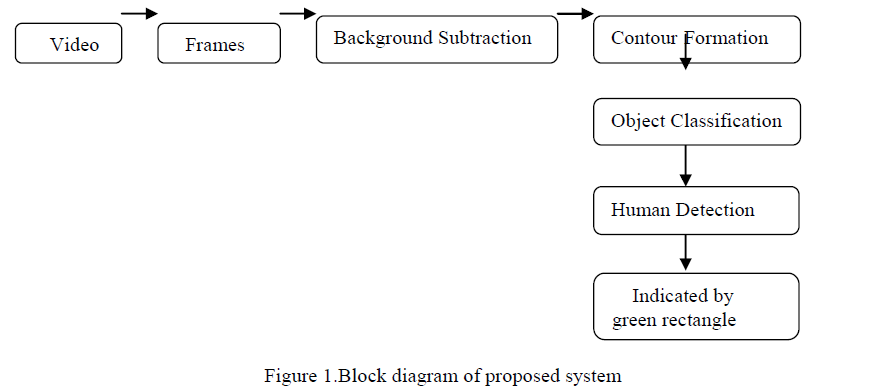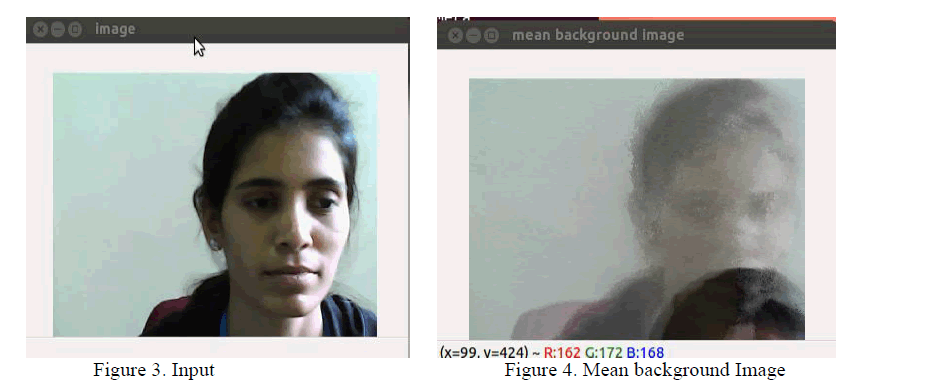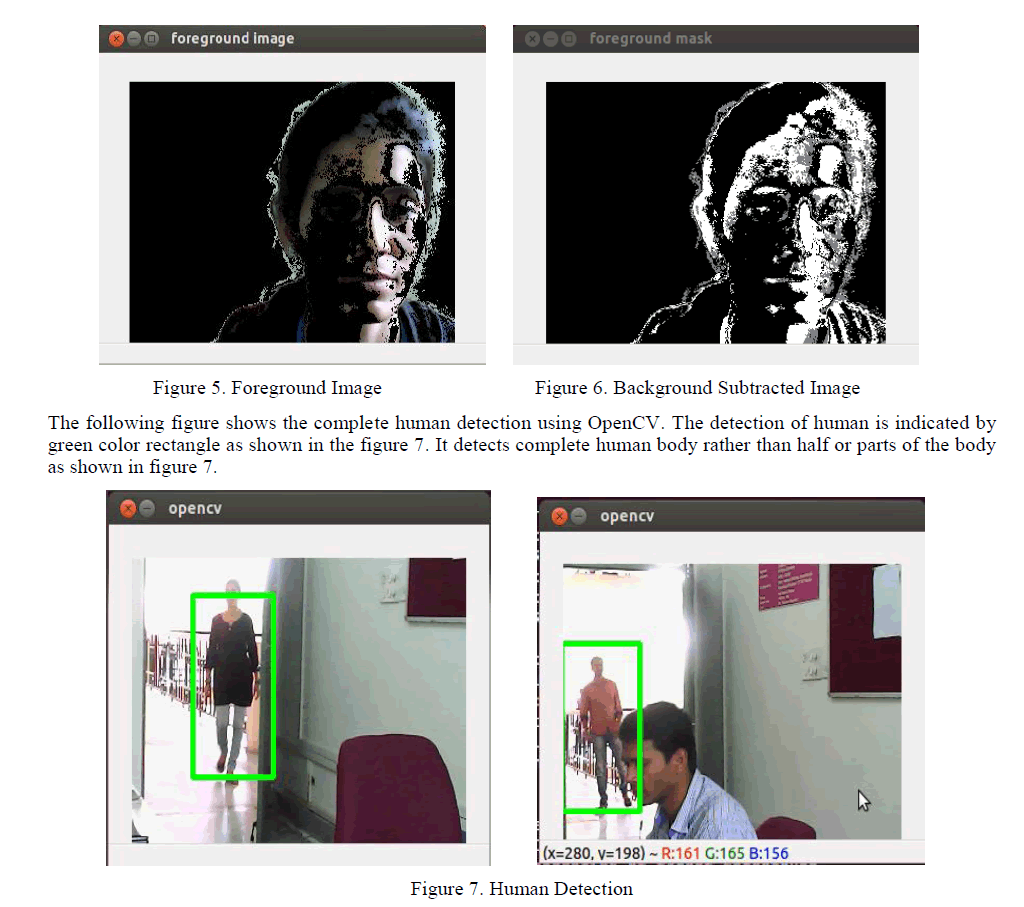ISSN ONLINE(2320-9801) PRINT (2320-9798)
ISSN ONLINE(2320-9801) PRINT (2320-9798)
Laxmi Tyapi, Sowmya K S
|
| Related article at Pubmed, Scholar Google |
Visit for more related articles at International Journal of Innovative Research in Computer and Communication Engineering
Video surveillance is the most effective means of ensuring safety. It enables a security to monitor wide range areas. In general, surveillance is to make a unit of three different phases i.e., Object segmentation, Object classification and Object tracking. Object segmentation is a method of partitioning a image into something which is easier to analyse and more meaningful. Object tracking deals with the estimation of the trajectory of the moving object. This paper mainly deals with the object classification. Object classification is mainly used to classify human and nonhuman parts. This paper implements real time detection of human. It is implemented using Intel Atom Processor using OpenCV.
KEYWORDS |
| Video surveillance, object segmentation, object classification, object tracking, contour formation, background subtraction |
I. INTRODUCTION |
| One of the effective tool of the surveillance is the video surveillance. Due to the increase in terrorism, violence and illegal activities there is a need for identification technique using video surveillance. The video surveillance systems not only need to track the moving objects but also interpret their patterns of behaviours. This means solving the information and integration the pattern. |
| Detecting human in real time surveillance is a challenging problem due to variations in pose, lighting conditions and complexity of backgrounds. Because of such parameters it differs from outdoor and indoor. Open Source Computer Vision (OpenCV) software is a powerful library which contains image processing tools especially when dealing with real time image processing. OpenCV is a free software library which is written in C++ and C and it runs under Linux. It is developed by Intel Russia research centre in Nizhny Novgorod. |
| The organization of the remaining part of the paper is as follows: Section 2 gives a literature survey on human detection techniques. Section 3 gives an proposed methodology for detecting human and brief explanation about different modules of the system. Section 4 gives explanation about result analysis of the proposed work. Section 5 concludes the paper. |
II. RELATED WORK |
| This section provides a review on different methods for human detection and background subtraction. In paper [1], “Jae Kyu Suhr and Ho Gi Jung” explains a technique for background subtraction called MoG (Mixtures of Gaussians) mainly for Bayer pattern image. It uses Gaussian probabilistic density function on „nâ recent frames. This technique classifies the object nearer to the observer. The accuracy of the Mixture of Gaussians technique is same for both RGB and gray images [1]. |
| In second paper [2] “Changickkim and Wonjun Kim” explains about FCH (Fuzzy Colored Histogram) background subtraction technique. This technique minimizes the color variations in the image. But in case of real time applications histograms are not suitable. |
| In paper [3] “T. MohanRaj A. Nandini” proposes a method of object classification for both outdoor and indoor conditions. In this adaptive statistical background model is used for background subtraction. To separate human and non-human parts Silhouette based method is used. |
III. PROPOSED WORK |
| A. Bock Diagram |
| The proposed work of this paper mainly consists of different modules like background subtraction, contour formation and object classification as shown in the figure 1. |
 |
| The proposed work of this paper is as shown in the figure 1. First the given video is converted into several frames. As this paper deals with the real time implementation conversion of video into frames is not shown separately. The background subtraction of these frames is done to extract particular object or human for further processing. Next module is contour formation or edge detection operation is to be performed on background subtracted image. For object classification, some typical poses of human is stored as a database. Then the image obtained from contour formation is compared with the database and most likely pose or human is detected. The detected human is indicated by a green color rectangle. |
| B. Modules |
| The workflow of this paper consists of video as input as shown in figure 1. The first step is to convert the video input into different frames. Frames are images obtained from the video. These frames are processed through different modules as shown in the figure 1. The different modules are background subtraction, contour formation and object classification. |
| C. Modules description |
| This section gives brief explanation of individual module. |
Background Subtraction |
 |
| Background subtraction is one of the widely used preprocessing techniques used in many applications. It is popular approach to detect moving objects. The main goal of this module is to extract an object from background in an image. There are different background subtraction techniques such as Frame Differencing method, Mean filter method, Running Gaussian average and Background Mixture Models etc. The simple and easy method is frame differencing method as shown in the figure 2. |
| This process has background model or one frame as a reference frame, then the difference between the current frame and background frame is obtained. If the obtained difference is greater than the threshold value then the object is detected as a foreground mask. This technique can be formulated as, |
| | Framei -Framei-1 | > Threshold (1) |
| Advantages of this technique are easy to implement, more robust to noise and change in light conditions. |
Contour Formation |
| Object classification needs contour formation as a preprocessing step. Contour defines the boundary values of an object in a frame or image. Hence it is used to extract the general shape of the object. It is also called as boundary detection or edge detection. |
Object Classification |
| Object classification is last module of the proposed work. It is used to classify the detected object type such as human or non-human. In this paper, object classification will be implemented using Silhouette based method i.e., few object silhouettes are stored as the database to classify the objects. Silhouette is a dark outline of some object against brighter background. The output of contour formation is of same kind. |
IV. EXPERIMENTAL RESULTS |
| The input is taken as a real time i.e., video input is taken from webcam. It is converted to frames and background subtraction is also performed as shown in the following figures. Figure 3 shows the input video from the webcam. Figure 4 indicates the mean background image. It is taken as reference frame for background subtraction. |
 |
| Figure 5 is the foreground image i.e., it recognizes the object or human nearer to observer. It is background subtracted image but not that clear. Figure 6 indicates the exact background subtracted image. |
 |
V. CONCLUSION |
| The main goal of the proposed approach is to identify the human from the webcam. The human might be in different positions, detection is done using OpenCV. Human detection from video surveillance has many more applications like people counting, abnormal event detection etc. Frame differencing method is used to implement background subtraction. The future scope of this paper includes the identification of the non-human part also so that we can classify as human and non-human parts in a video. |
References |
|